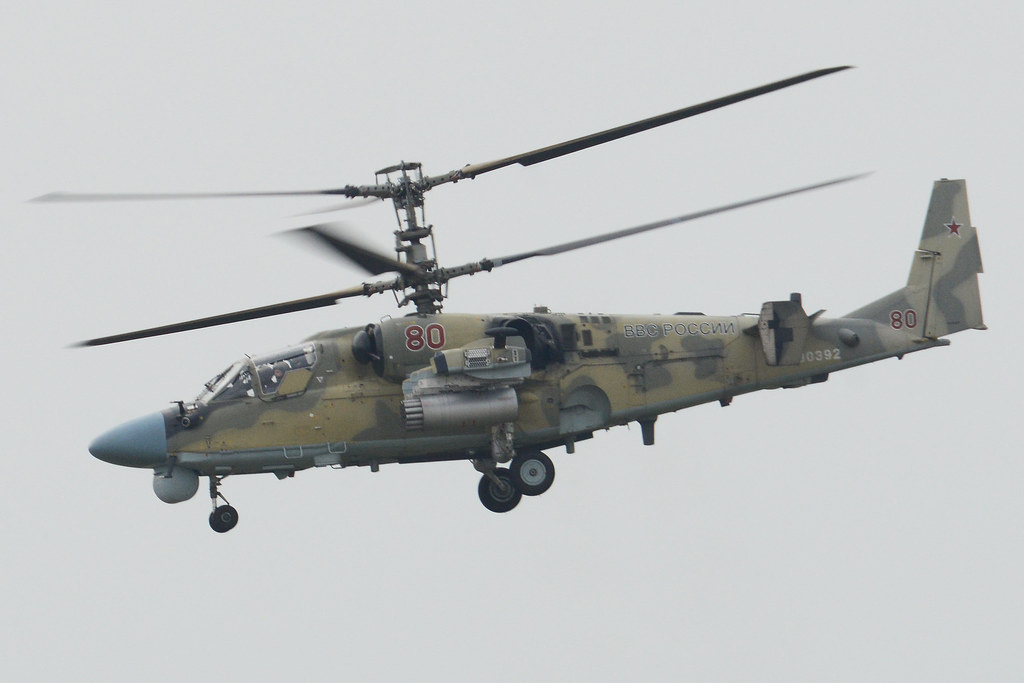
The Russian Aerospace Forces are currently evaluating the latest version of the Ka-52M attack helicopter, a formidable addition to their arsenal. Recent reports from Russian media in September suggest that the Ka-52M is now equipped with a ventral all-round radar station operating in the centimeter frequency range, setting a new standard for cutting-edge technology.
This advanced radar system provides Ka-52M pilots with superior control in challenging environmental conditions where optical visibility is limited. A defense industry insider revealed to RIA Novosti that the Ka-52M can detect a wide range of air and ground targets, including enemy aircraft, helicopters, UAVs, armored vehicles, and personnel, all in high-definition radio vision mode.
The source also mentioned that the helicopter’s new radar system allows it to perform reconnaissance and target acquisition under various weather conditions and at any time of day, even in the presence of significant natural or artificial radio interference. This development also improves the helicopter’s ability to detect targets with low radar reflectivity.
Insider information suggests that the Ka-52M can use Whirlwind or Product 305 missiles to engage smaller, tank-like enemy targets in zero visibility conditions. Moreover, the helicopter can reportedly operate independently of external sources, relying solely on its targeting data to provide accurate coordinates of enemy locations.
Earlier this year, another source confirmed that the Ka-52M has added Product-305 missiles to its offensive arsenal. The same source disclosed that this upgraded helicopter is being deployed in the Northern Military District region.
As for the Ka-52M’s field testing environment, a source informed the agency that there are plans to test the helicopter and its new radar system in Ukraine’s war-torn sectors, euphemistically referred to as the “special military operation” zone by Russian forces. While this information remains unverified, it is well-known that both sides in the ongoing conflict in Ukraine have used this theater to test their latest capabilities.
Russian news reports about the upgraded Ka-52M’s capabilities seem credible. Improvements have likely been made to the attack helicopter’s radar and electronic warfare functions.
A report published on September 4 of this year by the Royal United Services Institute [RUSI] provided valuable insights. The report, titled “Stormbreak: Fighting Through Russian Defensives in Ukraine’s Offensive 2023,” was the result of an in-depth analysis by Dr. Jack Watling and Nick Reynolds.
The report details the complex electronic warfare [EW] strategies used by the Russian Air Force against Ukrainian institutions. Interestingly, the Ukrainian military has noticed a correlation between the lifting of GPS jamming in Russian units and subsequent air strikes, highlighting the need for accurate navigation to coordinate these operations. This finding is particularly relevant because both militaries use similar platforms, as emphasized by the authors of the report.
At present, Russian helicopters are operating close to the frontline, which the report identifies as a problem for Russian aviation. The reasoning behind this is that the close proximity of helicopters to the frontline inevitably places ground headquarters and their refueling or arming points within the same area, making them vulnerable to Ukrainian artillery fire.
While there has been no official update on the status of the latest Ka-52M tests, it has been nearly a month since it was announced that state-level testing of the new Ka-52M is taking place in Ukraine. Shortly after this announcement, Moscow began forming a new division within the Russian airborne units.
According to sources from the Ministry of Defense who spoke with Izvestia, this decision was made in response to an increase in both helicopter and tank units.
This significant strategic enhancement has been largely influenced by lessons learned from Russia’s military operation in Ukraine. The goal? To enhance the effectiveness of the “wing infantry.”
It appears that initial plans to incorporate an all-army aviation brigade within the Airborne Forces, which were shelved prior to the formation of the Northern Military District, are now being reconsidered.
Colonel-General Andrey Serdyukov, the leader of the Airborne Forces, previously admitted to Izvestia that the use of army aviation helicopters allows airborne units to effectively counter fast-moving enemy formations “under various physical and geographical conditions,” regardless of the availability of an airport network.
Colonel Valery Yuriev, Chairman of the Union of Russian Paratroopers, disclosed to Izvestia an experimental formation used during pre-operational exercises. He elaborated, “The deployment of similar helicopter units was enabled and the subsequent exercises significantly increased the maneuverability and firepower of the paratroopers. This innovative formation strategy holds great potential.”
These ongoing efforts indicate Russia’s aim to enhance the combat effectiveness of its military units stationed in Ukraine. The Ka-52 has demonstrated its effectiveness against Ukrainian countermeasures. Its pivotal role in the future of this conflict seems virtually guaranteed.




